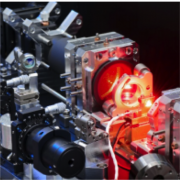Higher atmospheric layers are becoming more and more interesting for climate researchers, but the areas above 40 km are only directly accessible with sounding rockets. A newly developed LIDAR system (Light Detection and Ranging) with a diode-pumped alexandrite laser will soon make such research possible remotely. Scientists from the Leibniz-Institute of Atmospheric Physics (IAP) and the Fraunhofer Institute for Laser Technology ILT are developing a system that is not only easy to transport but also works independently. In the future, a LIDAR network will be able to deliver data from the atmosphere continuously and on a large scale.
Climate change is a hot topic. Understanding it scientifically, however, requires valid models of temperature and wind distribution in the atmosphere. Measurements in the upper stratosphere up to the thermosphere (30-120 km) are difficult to capture. An innovative ground-based LIDAR system now offers a new approach to collecting this data. Since the 1990s, the IAP in Kühlungsborn has been pioneering research into the mesosphere with its own LIDAR systems. Owing to its flash lamp-pumped alexandrite laser, the system filled a complete ship container. Its use was also limited since it consumed a great deal of energy and required complex alignment.
この情報へのアクセスはメンバーに限定されています。ログインしてください。メンバー登録は下記リンクをクリックしてください。

